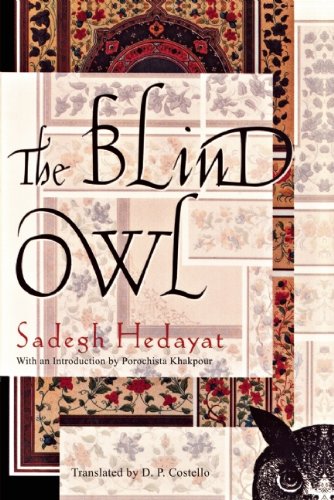
![]() The Blind Owl by Sadegh Hedayat
The Blind Owl by Sadegh Hedayat
My ongoing attempt to read all 200 books spotlighted in Stephen Jones’s and Kim Newman‘s two excellent overview volumes, Horror: 100 Best Books and Horror: Another 100 Best Books, has led me to some fairly unusual finds. Case in point: Sadegh Hedayat‘s The Blind Owl, which is — or so claims the Grove Press edition currently in print–“the most important work of modern Iranian literature.” Originally published in Bombay in 1937 under the Persian title Buf-i Kur, it first appeared in Tehran four years later as a serial in a daily newspaper and was finally translated into English in 1958. Writing about the short novel in Horror: Another 100 Best Books, author Robert Irwin tells us “there is little logic to the narrative,” and that statement may be putting it lightly. Indeed, the novel is so very dreamlike and hallucinatory that it all but defies rational analysis, as well as easy summation.
The book cleaves into two fairly discrete sections. In the first, our nameless narrator — an alcoholic, opium-addicted painter of pen cases — gazes out his window and becomes obsessed with a beautiful, dark-haired woman he sees. This woman later seems to come to our narrator’s room, lays down on his bed and dies. After painting her eyes, he cuts her up into pieces with his bone-handled knife, stuffs her in a suitcase, and is driven by horse-drawn hearse to a cemetery to bury her. Once back at home, he consumes more opium and awakens to a seemingly new identity. In this second section, he is the opium-addicted husband of a dark-haired woman (possibly the same woman as in his previous identity?) whom he only calls “the bitch,” for the good reason that she has never agreed to sleep with him. A la Deanie Loomis in Splendor in the Grass, this perpetual lack of sexual gratification seems to drive the narrator to madness, in addition to a rapid physical deterioration. It ultimately ends with our narrator entertaining an urge to take his bone-handled knife to the black-haired woman.
As I said, it’s not an easy book to summarize, and I despair of giving anyone a sense of the strangeness or fevered intensity to be found in this slim volume. Of all the narrators to be found in modern literature, the one (or is it two?) to be found here is perhaps the most unreliable; as he himself tells us, “Is not everything that I feel, see and think something entirely imaginary, something utterly different from reality?” He is undeniably a madman recluse, surely a paranoiac, possibly schizophrenic, and patently always ripped on either opium or booze. As is the case with certain works of cult science fiction author Philip K. Dick (I am thinking most especially of such mind-benders as Lies, Inc. and The Three Stigmata of Palmer Eldritch), here, the depiction of an altered state (such as psychosis) becomes even stranger by dint of drugs (opium), and then even weirder as our demented addict falls into a dream. As the narrator tells us early on, “after a certain point, instead of alleviating the pain, [opium and booze] only intensify it.” Eventually, the reader cannot tell what is real and what is delusion. Indeed, the narrator of the book’s first section may be nothing but a figment of the second narrator’s imagination, or vice versa. There is just no way to tell, no definitive explanation to be had.
The book is nothing if not open ended, and such ambiguity can make for a frustrating experience for some. (Can such an irrational work truly be the best and most important that Iran has to offer from the past 75 years? I wouldn’t know; this is the first piece of Persian lit that I’ve ever read.) Our nameless narrator repeats himself constantly, very often in the same paragraph, seemingly without knowledge of having done so. Many of his mental wanderings lead nowhere in particular, and much that he tells us is contradicted by other statements (I’d like to say “facts,” but again, it is virtually impossible to say with certainty what is fact, what is fiction, what is surrealist dream and what is outré hallucination here). I am surprised, almost, that The Blind Owl did not receive a sort of “stoner renown” back in the mid-1960s; it seems just the sort of book that might have been championed by the lysergically enhanced back when!
Coming in at a mere 130 large-print pages, The Blind Owl is a book that can be easily read in a sitting or two, and to the author’s (and translator D.P. Costello‘s) credit, it is very well written. A fascinating exercise in the macabre (it should come as no surprise that Hedayat was a big fan of Edgar Allan Poe), horrifying without ever being truly scary, and ultimately leaving the reader with a sense of bafflement, it is surely a work that will linger in the memory. Hedayat, sad to say, gassed himself to death in 1951, at the age of 48, while living in Paris. It would seem that some of the mental torment so apparent in his most famous work’s narrator(s) was shared by the author himself. As Irwin reports, “As a youth, Hedayat tried to drown himself. His masterpiece is a novel to drown in. But note that drowning is rarely pleasant.”



Do it! One of the best things I've read in recent years.
This reminds me. I want to read Addie LaRue.
We’re in total agreement David!
I felt just the same. The prose and character work was excellent. The larger story was unsatisfying, especially compared to…
Hmmm. I think I'll pass.